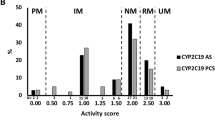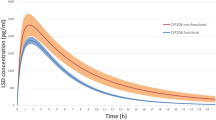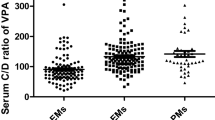Abstract
Tardive dyskinesia (TD) is a common and potentially irreversible side effect associated with long-term treatment with typical antipsychotics. Approximately, 80% or more of patients with schizophrenia are smokers. Smoking is a potent inducer of the CYP1A2 enzyme, and is known to cause a significant decrease in plasma concentrations of some antipsychotics. Therefore, person-to-person differences in the extent of CYP1A2 induction by smoking may contribute to risk for the development of TD. Recently, a (C→A) genetic polymorphism in the first intron of the CYP1A2 gene was found to be associated with variation in CYP1A2 inducibility in healthy volunteer smokers. The aim of this study was to test the clinical importance of the (C→A) polymorphism in CYP1A2 in relation to TD severity. A total of 85 patients with schizophrenia were assessed for TD severity using the Abnormal Involuntary Movement Scale (AIMS), and were subsequently genotyped for the (C→A) polymorphism in CYP1A2. The mean AIMS score in patients with the (C/C) genotype (associated with reduced CYP1A2 inducibility) was 2.7- and 3.4-fold greater than in those with the (A/C) or (A/A) genotype, respectively (F[2,82] = 7.4, P = 0.0007). Further, a subanalysis in the 44 known smokers in our sample, revealed a more pronounced effect. The means AIMS score in smokers was 5.4- and 4.7-fold greater in (C/C) homozygotes when compared to heterozygotes and (A/A) homozygotes, respectively (F[2,41] = 3.7, P = 0.008). These data suggest that the (C→A) genetic polymorphism in the CYP1A2 gene may serve as a genetic risk factor for the development of TD in patients with schizophrenia. Further studies in independent samples are warranted to evaluate the applicability of our findings to the general patient population receiving antipsychotic medications.
This is a preview of subscription content, access via your institution
Access options
Subscribe to this journal
Receive 12 print issues and online access
$259.00 per year
only $21.58 per issue
Buy this article
- Purchase on Springer Link
- Instant access to full article PDF
Prices may be subject to local taxes which are calculated during checkout



Similar content being viewed by others
References
Kane JM, Smith JM . Tardive dyskinesia: prevalence and risk factors, 1959 to 1979 Arch Gen Psychiatry 1982; 39: 473–481
Chakos MH, Alvir JM, Woerner MG, Koreen A, Geisler S, Mayerhoff D et al. Incidence and correlates of tardive dyskinesia in first episode of schizophrenia Arch Gen Psychiatry 1996; 53: 313–319
Bergen J, Kitchin R, Berry G . Predictors of the course of tardive dyskinesia in patients receiving neuroleptics Biol Psychiatry 1992; 32: 580–594
Peck CC, Barr WH, Benet LZ, Collins J, Desjardins RE, Furst DE et al. Opportunities for integration of pharmacokinetics, pharmacodynamics, and toxicokinetics in rational drug development Clin Pharmacol Ther 1992; 51: 465–473
Rowland M, Tozer TN (eds) . Clinical Pharmacokinetics. Concepts and Applications. 3rd edition Williams & Wilkins: Pennsylvania 1995
Ozdemir V, Masellis M, Basile VS, Kalow W, Meltzer HY, Lieberman JA et al. Variability in response to clozapine: potential role of cytochrome P450 1A2 and the dopamine D4 receptor gene CNS Spectrums 1999; 4: 30–56
Weinhold P, Wegner JT, Kane JM . Familial occurrence of tardive dyskinesia J Clin Psychiatry 1981; 42: 165–166
Yassa R, Ananth J . Familial tardive dyskinesia Am J Psychiatry 1981; 138: 1618–1619
Waddington JL, Youssef HA . The expression of schizophrenia, affective disorder and vulnerability to tardive dyskinesia in an extensive pedigree Br J Psychiatry 1988; 153: 376–381
O'Callaghan E, Larkin C, Kinsella A, Waddington JL . Obstetric complications, the putative familial-sporadic distinction, and tardive dyskinesia in schizophrenia Br J Psychiatry 1990; 157: 578–584
Rosengarten H, Schweitzer JW, Friedhoff AJ . Possible genetic factors underlying the pathophysiology of tardive dyskinesia Pharmacol Biochem Behav 1994; 49: 663–667
Steen VM, Lovlie R, MacEwan T, McCreadie RG . Dopamine D3-receptor gene variant and susceptibility to tardive dyskinesia in schizophrenic patients Mol Psychiatry 1997; 2: 139–145
Basile VS, Masellis M, Badri F, Paterson AD, Meltzer HY, Lieberman JA et al. Association of the Mscl polymorphism of the dopamine D3 receptor gene with tardive dyskinesia in schizophrenia Neuropsychopharmacology 1999; 21: 17–27
Segman R, Neeman T, Heresco-Levy U, Finkel B, Karagichev L, Schlafman M et al. Genotypic association between the dopamine D3 receptor and tardive dyskinesia in chronic schizophrenia Mol Psychiatry 1999; 4: 247–253
Bertilsson L, Dahl ML, Ekqvist B, Llerena A . Disposition of the neuroleptics perphenazine, zuclopenthixol, and haloperidol cosegregates with polymorphic debrisoquine hydroxylation Psychopharmacol Ser 1993; 10: 230–237
Bertilsson L, Dahl M-L . Polymorphic drug oxidation. Relevance to the treatment of psychiatric disorders CNS Drugs 1996; 5: 200–223
Ozdemir V, Naranjo CA, Herrmann N, Reed K, Sellers EM, Kalow W . Paroxetine potentiates the central nervous system side-effects of perphenazine: contribution of cytochrome P450 2D6 inhibition in vivo Clin Pharmacol Ther 1997; 62: 334–347
Kalow W . Pharmacogenetics in biological perspective Pharmacol Rev 1997; 49: 369–379
Kalow W . Interethnic variation of drug metabolism Trends Pharmacol Sci 1991; 12: 102–107
Bertilsson L . Geographical/interracial differences in polymorphic drug oxidation. Current state of knowledge of cytochromes P450 (CYP) 2D6 and 2C19 Clin Pharmacokinet 1995; 29: 192–209
Lin K-M, Poland RE, Wan Y-JY, Smith MW, Lesser IM . The evolving science of pharmacogenetics: clinical and ethnic perspectives Psychopharmacol Bull 1996; 32: 205–217
Spina E, Sturiale V, Valvo S, Ancione M, Di Rosa AE, Meduri M et al. Debrisoquine oxidation phenotype and neuroleptic-induced dystonic reactions Acta Psychiatr Scand 1992; 86: 364–366
Arthur H, Dahl ML, Siwers B, Sjoqvist F . Polymorphic drug metabolism in schizophrenic patients with tardive dyskinesia J Clin Psychopharmacol 1995; 15: 211–216
Pollock BG, Mulsant BH, Sweet RA, Rosen J, Altieri LP, Perel JM . Prospective cytochrome 450 phenotyping for neuroleptic treatment in dementia Psychopharmacol Bull 1995; 31: 327–331
Andreassen OA, MacEwan T, Gulbrandsen AK, McCreadie RG, Steen VM . Non-functional CYP2D6 alleles and risk for neuroleptic-induced movement disorders in schizophrenic patients Psychopharmacology 1997; 131: 174–179
Armstrong M, Daly AK, Blennerhassett R, Ferrier N, Idle JR . Antipsychotic drug-induced movement disorders in schizophrenics in relation to CYP2D6 genotype Br J Psychiatry 1997; 170: 23–26
Kapitany T, Meszaros K, Lenzinger E, Schindler SD, Barnas C, Fuchs K et al. Genetic polymorphisms for drug metabolism (CYP2D6) and tardive dyskinesia in schizophrenia Schizophr Res 1998; 32: 101–106
Ohmori O, Suzuki T, Kojima H, Shinkai T, Terao T, Mita T et al. Tardive dyskinesia and debrisoquine 4-hydroxylase (CYP2D6) genotype in Japanese schizophrenics Schizophr Res 1998; 32: 107–113
Shimada T, Yamazaki H, Mimura M, Inui Y, Guengerich FP . Interindividual variations in human liver cytochrome P-450 enzymes involved in the oxidation of drugs, carcinogens and toxic chemicals: studies with liver microsomes of 30 Japanese and 30 Caucasians J Pharmacol Exp Ther 1994; 270: 414–423
Brøsen K, Gram LF . Clinical significance of the sparteine/debrisoquine oxidation polymorphism Eur J Clin Pharmacol 1989; 36: 537–547
Sindrup SH, Brosen K, Gram LF, Hallas J, Skjelbo E, Allen A et al. The relationship between paroxetine and the sparteine oxidation polymorphism Clin Pharmacol Ther 1992; 51: 278–287
Jerling M, Dahl ML, Aberg-Wistedt A, Liljenberg B, Landell NE, Bertilsson L et al. The CYP2D6 genotype predicts the oral clearance of the neuroleptic agents perphenazine and zuclopenthixol Clin Pharmacol Ther 1996; 59: 423–428
Linnet K, Wiborg O . Steady-state serum concentrations of the neuroleptic perphenazine in relation to CYP2D6 genetic polymorphism Clin Pharmacol Ther 1996; 60: 41–47
Ozdemir V, Tyndale RF, Reed K, Herrmann N, Sellers EM, Kalow W et al. Paroxetine steady-state concentration in relation to CYP2D6 genotype in extensive metabolizers J Clin Psychopharmacol 1999; 19: 472–475
Dahl-Puustinen ML, Liden A, Alm C, Nordin C, Bertilsson L . Disposition of perphenazine is related to polymorphic debrisoquin hydroxylation in human beings Clin Pharmacol Ther 1989; 46: 78–81
Pantuck EJ, Pantuck CB, Anderson KE, Conney AH, Kappas A . Cigarette smoking and chlorpromazine disposition and actions Clin Pharmacol Ther 1982; 31: 533–538
Stimmel GL, Falloon IR . Chlorpromazine plasma levels, adverse effects, and tobacco smoking: case report J Clin Psychiatry 1983; 44: 420–422
Ereshefsky L, Jann MW, Saklad SR, Davis CM, Richards AL, Burch NR . Effects of smoking on fluphenazine clearance in psychiatric inpatients Biol Psychiatry 1985; 20: 329–332
Jann MW, Saklad SR, Ereshefsky L, Richards AL, Harrington CA, Davis CM . Effects of smoking on haloperidol and reduced haloperidol plasma concentrations and haloperidol clearance Psychopharmacology (Berl) 1986; 90: 468–470
Miller DD, Kelly MW, Perry PJ, Coryell WH . The influence of cigarette smoking on haloperidol pharmacokinetics Biol Psychiatry 1990; 28: 529–531
Shimoda K, Someya T, Morita S, Hirokane G, Noguchi T, Yokono A et al. Lower plasma levels of haloperidol in smoking than in nonsmoking schizophrenic patients Ther Drug Monit 1999; 21: 293–296
Kalow W, Tang BK . Caffeine as a metabolic probe: exploration of the enzyme-inducing effect of cigarette smoking Clin Pharmacol Ther 1991; 49: 44–48
Hughes JR, Hatsukami DK, Mitchell JE, Dahlgren LA . Prevalence of smoking among psychiatric outpatients Am J Psychiatry 1986; 143: 993–997
Lohr JB, Flynn K . Smoking and schizophrenia Schizophr Res 1992; 8: 93–102
Smith SS, Fiore MC . The epidemiology of tobacco use, dependence, and cessation in the United States Prim Care 1999; 26: 433–461
Preskorn SH . Clinically relevant pharmacology of selective serotonin reuptake inhibitors. An overview with emphasis on pharmacokinetics and effects on oxidative drug metabolism Clin Pharmacokinet 1997; 32: (suppl 1) 1–21
Kashuba AD, Nafziger AN, Kearns GL, Leeder JS, Gotschall R, Rocci ML Jr et al. Effect of fluvoxamine therapy on the activities of CYP1A2, CYP2D6, and CYP3A as determined by phenotyping Clin Pharmacol Ther 1998; 64: 257–268
Ozdemir V, Naranjo CA, Shulman RW, Herrmann N, Sellers EM, Kalow W et al. Determinants of interindividual variability and extent of CYP2D6 and CYP1A2 inhibition by paroxetine and fluvoxamine in vivo J Clin Psychopharmacol 1998; 18: 198–207
Rasmussen BB, Nielsen TL, Brøsen K . Fluvoxamine is a potent inhibitor of the metabolism of caffeine in vitro Pharmacol Toxicol 1998; 83: 240–245
Daniel DG, Randolph C, Jaskiw G, Handel S, Williams T, Abi-Dargham A et al. Coadministration of fluvoxamine increases serum concentrations of haloperidol J Clin Psychopharmacol 1994; 14: 340–343
von Moltke LL, Greenblatt DJ, Duan SX, Schmider J, Kudchadker L, Fogelman SM et al. Phenacetin O-deethylation by human liver microsomes in vitro: inhibition by chemical probes, SSRI antidepressants, nefazodone and venlafaxine Psychopharmacology 1996; 128: 398–407
von Moltke LL, Greenblatt DJ, Court MH, Duan SX, Harmatz JS, Shader RI . Inhibition of alprazolam and desipramine hydroxylation in vitro by paroxetine and fluvoxamine: comparison with other selective serotonin reuptake inhibitor antidepressants J Clin Psychopharmacol 1995; 15: 125–131
Miller M, Opheim KE, Raisys VA, Motulsky AG . Theophylline metabolism: variation and genetics Clin Pharmacol Ther 1984; 35: 170–182
Kalow W, Tang BK . Use of caffeine metabolite ratios to explore CYP1A2 and xanthine oxidase activities Clin Pharmacol Ther 1991; 50: 508–519
Kalow W, Tang BK, Endrenyi L . Hypothesis: comparisons of inter- and intra-individual variations can substitute for twin studies in drug research Pharmacogenetics 1998; 8: 283–289
Sachse C, Brockmoller J, Bauer S, Roots I . Functional significance of C→A polymorphism in intron 1 of the cytochrome P450 CYP1A2 gene tested with caffeine Br J Clin Pharmacol 1999; 47: 445–449
Lahiri DK, Nurnberger JI Jr . A rapid nonenzymatic method for the preparation of HMW DNA from blood for RFLP studies Nucleic Acids Res 1991; 19: 5444
Kalow W . Pharmacogenetics: Heredity and the Response to Drugs WB Saunders: Philadelphia 1962
Vesell ES . Reflections from distant cuvettes Drug Metab Rev 1996; 28: 493–511
Weber WW . Pharmacogenetics Oxford University Press: New York 1997
Kalow W, Ozdemir V, Tang BK, Tothfalusi L, Endrenyi L . The science of pharmacological variability: an essay Clin Pharmacol Ther 1999; 66: 445–447
Okey AB . Enzyme induction in the cytochrome P-450 system Pharmacol Ther 1990; 45: 241–298
Albers LJ, Reist C, Helmeste D, Vu R, Tang SW . Paroxetine shifts imipramine metabolism Psychiatry Res 1996; 59: 189–196
Kalow W . Pharmacogenetic research: a revolutionary science J Psychiatry Neurosci 1999; 24: 139–140
Nakajima M, Yokoi T, Mizutani M, Kinoshita M, Funayama M, Kamataki T . Genetic polymorphism in the 5′-flanking region of human CYP1A2 gene: effect on the CYP1A2 inducibility in humans J Biochem 1999; 125: 803–808
Tang BK, Kalow W . Assays for CYP1A2 by testing in vivo metabolism of caffeine in humans Meth Enzymol 1996; 272: 124–131
Kirch DG, Alho AM, Wyatt RJ . Hypothesis: a nicotine-dopamine interaction linking smoking with Parkinson's disease and tardive dyskinesia Cell Mol Neurobiol 1988; 8: 285–291
Nilsson A, Waller L, Rosengren A, Adlerberth A, Wilhelmsen L . Cigarette smoking is associated with abnormal involuntary movements in the general male population—a study of men born in 1933 Biol Psychiatry 1997; 41: 717–723
Basile VS, Ozdemir V, Masellis M, Walker M, Kalow W, Meltzer HY et al. Tardive dyskinesia in schizophrenia: potential role and interaction of the cytochrome P450 1A2 and dopamine D3 receptor genes Am J Hum Genet 1999; 65: 242
Macciardi FM, Basile VS, Kennedy JL . Modelling gene–gene interactions in complex traits Am J Hum Genet 1999; 65: 210
Acknowledgements
JL Kennedy is supported by operating grants from the Ontario Mental Health Foundation and the Medical Research Council of Canada (MT15007) and a NARSAD Independent Investigator Award. V Özdemir is supported by a postdoctoral fellowship from the Ontario Mental Health Foundation and a NARSAD Young Investigator Award.
Author information
Authors and Affiliations
Corresponding author
Rights and permissions
About this article
Cite this article
Basile, V., Özdemir, V., Masellis, M. et al. A functional polymorphism of the cytochrome P450 1A2 (CYP1A2) gene: association with tardive dyskinesia in schizophrenia. Mol Psychiatry 5, 410–417 (2000). https://doi.org/10.1038/sj.mp.4000736
Received:
Revised:
Accepted:
Published:
Issue Date:
DOI: https://doi.org/10.1038/sj.mp.4000736



